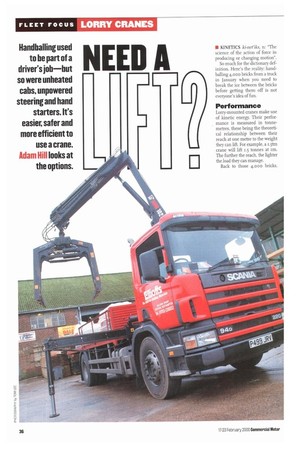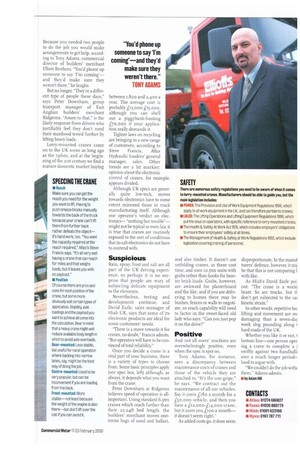EE A
Page 38

Page 39

If you've noticed an error in this article please click here to report it so we can fix it.
III KINETICS ki-neriks, n: "The science of the action of force in producing or changing motion".
So much for the dictionary definition. Here's the reality: handballing 4,000 bricks from a truck in January when you need to break the ice between the bricks before getting them off is not everyone's idea of fun.
Performance
Lorry-mounted cranes make use of kinetic energy. Their performance is measured in tonnemetres, these being the theoretical relationship between their reach at one metre to the weight they can lift. For example, a i.5tin crane will lift 1.5 tonnes at
The further the reach, the lighter the load they can manage.
Back to those 4,000 bricks. Because you needed two people to do the job you would make arrangements to get help, according to Tony Adams, commercial director of builders' merchant Elliott Brothers. "You'd phone up someone to say 'I'm coming'— and they'd make sure they weren't there," he laughs.
But no longer. "They're a different type of people these days," says Peter Downham, group transport manager of Fast Anglian builders' merchant Ridgeons. "Amen to that," is the likely response from drivers who justifiably feel they don't need their manhood tested further by lifting heavy loads.
Lorry-mounted cranes came on to the UK scene as long ago as the r96os, and at the beginning of the 21st century we find a mature domestic market buying between 1.800 and 2,400 a year. The average cost is probably fr3,000-ft5,000, although you can shell out a piggybank-busting £70,000 if your application really demands it.
Tighter laws on recycling are bringing in a new range of customers, according to
Steve Francis, Atlas Hydraulic Loaders' general manager, sales. Other trends are a bit murkier: opinion about the electronic control of cranes, for example, appears divided.
Although UK specs are generally quite low-tech, moves towards electronics have to some extent mirrored those in truck manufacturing itself, Although one operator's verdict on electronics— "nothing but trouble"— might not be typical or even fair, it is true that cranes are routinely exposed to the sort of conditions that in-cab electronics do not have to contend with.
Suspicious
Rain, spray, frost and salt are all part of the UK driving experience, so perhaps it is no surprise that people are wary of subjecting delicate equipment to the elements.
Nevertheless, testing and development continue, and David Earle, sales manager of Hiab UK, says that some of its electronic products are ideal for some customers' needs.
"There is a move towards it for cranes, no doubt," Francis admits. "But operators will have to be convinced of total reliability."
Once you decide a crane is a vital part of your business, there is a variety of types to choose from. Some basic principles apply (see spec box, left) although, as always, it depends what you want from the crane.
Peter Downham at Ridgeons believes speed of operation is allimportant. Using standard 6.5tm cranes which reach further than their 22-24ft bed length, the builders' merchant moves onetonne bags of sand and ballast,
and also timber. It doesn't use unfolding cranes, as these cost time, and uses ro.5tm units with grabs rather than hooks for heavier brick loads. Grabs, however, are awkward for plasterboard and the like, and if you are delivering to homes there may be bushes, fences or walls to negotiate, so reach capability will need to factor in the sweet-faced old lady who says: "Can you just pop it on the drive?"
Positive
And not all users' reactions are overwhelmingly positive, even when the spec is spot on.
Tony Adams, for instance, sees a discrepancy between maintenance costs of cranes and those of the vehicle they are attached to. "It's the one gripe," he says. "We contract out the maintenance of all our vehicles. Say it costs £180 a month for a £50,000 vehicle, and then you have a Lr2,000-f14,000 crane, but it costs you £70o a month— it doesn't seem right."
As added costs go. it does seem disproportionate. In the manui turers' defence, however, it mil be that this is not comparing 1 with like.
As Hiab's David Earle poi out: "The crane is a world beast. So are trucks, but tl don't get subjected to the sal kinetic strain."
In other words, repetitive he; lifting and movement are m( damaging than a seven-day week slog pounding along i hard roads of the UK.
Whether you like it or not, bottom line—one person °per ing a crane to complete a j swiftly against two handballi over a much longer period– hard to argue with.
"We couldn't do the job with them," Adams admits.
• by Adam Hifi








































































































